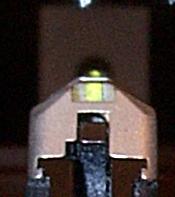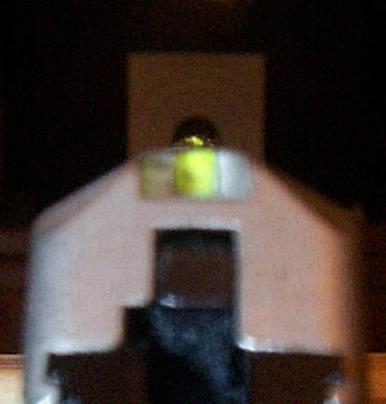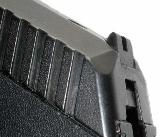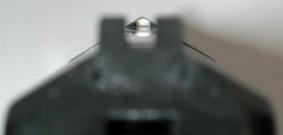Accuracy HintsBack to Kel-Tec stufforigonaly posted by Chan Bates on the KTOG message board. quote: Acceptable accuracy with a P-11, as with almost any gun, has a lot of variables. While the gun itself is capable of a certain degree of accuracy, the shooter is the bigger negative factor. Sight alignment, trigger control, grip, choice of ammo, flinching, distance to target, shooting conditions (indoor vs. outdoor, lighting, noise, other shooters nearby), poor eyesight, etc. etc. The first thing to do with any new gun, before firing, is to inspect it and clean it, then properly lube it. Next, with snap caps, dry fire it, at home, and practice lining up the sights and pressing the trigger to see if you can hold the gun on the target while accomplishing a fake shot. If you can't do it here, you won't be able to do it there (the range). Adjust your grip, trigger pull and anything else you can to dry fire right at the target without moving. Eventually, you will feel ready to go to the range. Function test first for at least a few mags, disregarding accuracy. If all is well and safe, then start in on accuracy testing. There is nothing more frustrating or confusing than doing something new, poorly, and not being able to figure out how to improve. So, the first thing to do is to remove as many of the (human) variables from the accuracy equation as possible: SHOOT FROM A GOOD REST! SHOOT AT 5 YARDS! SHOOT AT A REAL TARGET WITH AN AIMING POINT! ALIGN THE SIGHTS CORRECTLY (Front sight covering point of impact on a self defense gun)! STROKE THE TRIGGER (Do not stage or pull slowly)! USE TWO HANDS! Try different types of ammo, especially lighter loads and bullets at first (115 grn 9MM). Find out what the gun can do by eliminating as much human error as possible. Once you have established what the gun will do, now you can find out what you can do. Don't shoot your KT too much your first few times out. It is a lightweight that tends to wear new shooters out--causing shaking and inaccuracy. If you are having problems, stop, go home, and try the dry-fire method again. While the KT trigger is really much better than many double action revolvers and most double action pistols, meaning, lighter and smoother and about the same length of pull, it does cause many people problems. The length of pull and the weight of the pull are the safety on this gun. If you can be safe with a Glock or other single action trigger pull, you can adjust the KT trigger to be a little shorter (3/8") and lighter (7 LBS.). A trigger shoe permanently mounted helps trigger control. An overtravel stop definitely helps with accuracy. A Hogue Handall Jr. rubber grip sleeve will make the gun more comforatble to shoot for most people. A magazine extension/finger rest will give you a better grip on the gun. A shooting glove, trigger finger bare, can help with longer range sessions while you practice accuracy. You think accuracy with a P-11 is tough? Graduate to the big boys club and shoot the P-40 to find out what flinching is all about. If you can shoot a P-40 well, the P-11 is a pussy cat. I can now put three shots touching at 7 yards with my .44 mag because I have learned to shoot a P-40 well. Grip, sight alignment, trigger control, s t e a d y . . . BANG. Bullet goes where it is supposed to. One more thing--this is a close-range, self defense, small, lightweight, powerful pistol. It will never produce the same accuracy as other bigger, heavier guns. Don't worry about it. Can you hit the Center of Mass of a silhouette target at 7 yards every time? You're there! CB3 Taken from the same thread added by KeysBear quote: Bad guys don't stand still like they're taking a picture for a family photo album. Some bonehead was mocking me on another thread for my ideas about practicing quick shooting, impaired stances, and less than ideal arm positions. There's nothing wrong with learning the basics of target shooting and trying to shoot accurately, but I believe in adding some real life defensive shooting scenarios to your shooting regimen. Getting off a shot then retreating to a covered position could be what saves your life. A big part of defensive shooting is thinking out your cover possibilities, and knowing how to shoot effectively around your cover. Everyone should go through their own house and think out shooting angles and places to take cover if there was an intruder. Another thing. I know that I've got to react fast enough to get a good two handed grip on my P-11, or I could limp wrist and have no followup shot. I have gone out of my way to find out what the P-11, being my primary carry gun, will and won't do. I even have a good idea of how quickly I can rack the slide after a misfeed. The times that a misfeed happened to me I didn't just stand there and look at it. I acted like I had a bad guy coming after me and practiced how quickly I could clear it or just rack my slide and get off a follow up shot. Anyone can practice this on their first round - just lock the slide back, grip your gun normally, aim at your target, then rack the slide, get back on aim, and fire as quickly as possible. This skill could save your life. Regards, Keys  (swap from left to right for a left handed shooter) P-32 Site UsageMany people are not clear about how to properly use the P-32 sites. The front site should be directly over the rear site, and the bottom of it just touching the top of the rear site. Also the front site should be COVERING the target.This one would hit high because the front site is not touching the rear site (it is not low enough): 
This one is about right: 
Also those who like a more traditional sight picture have the option of the P-sight: 

|